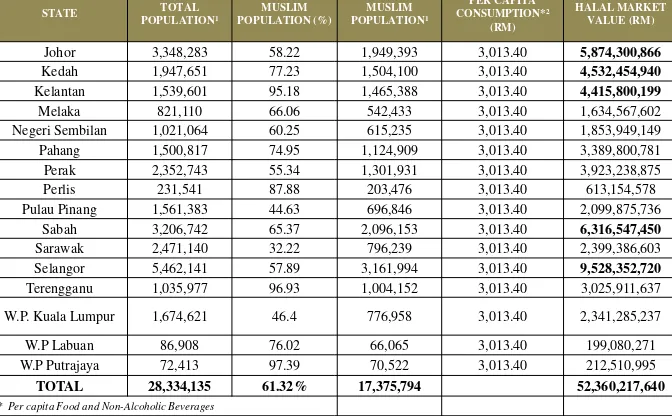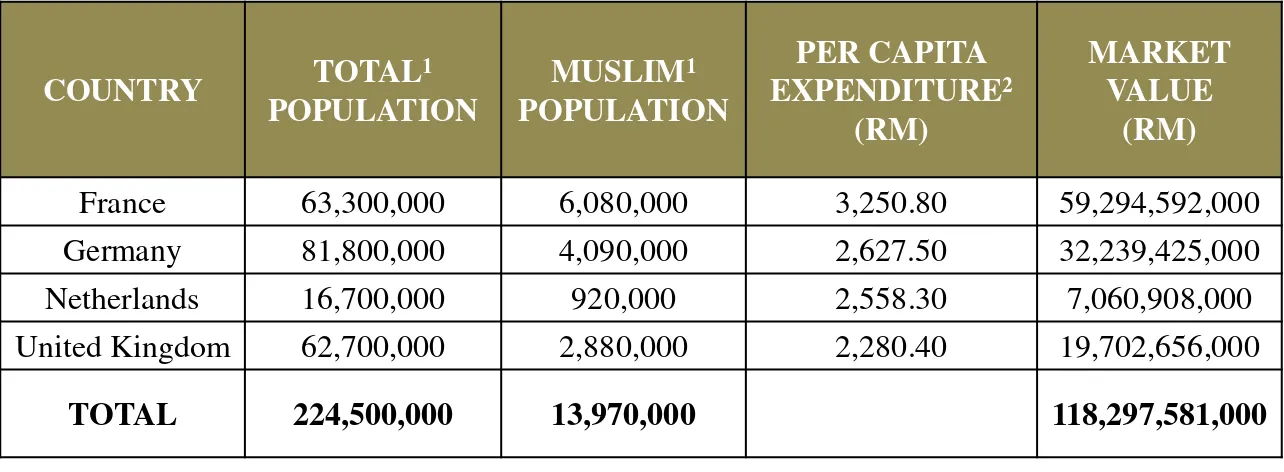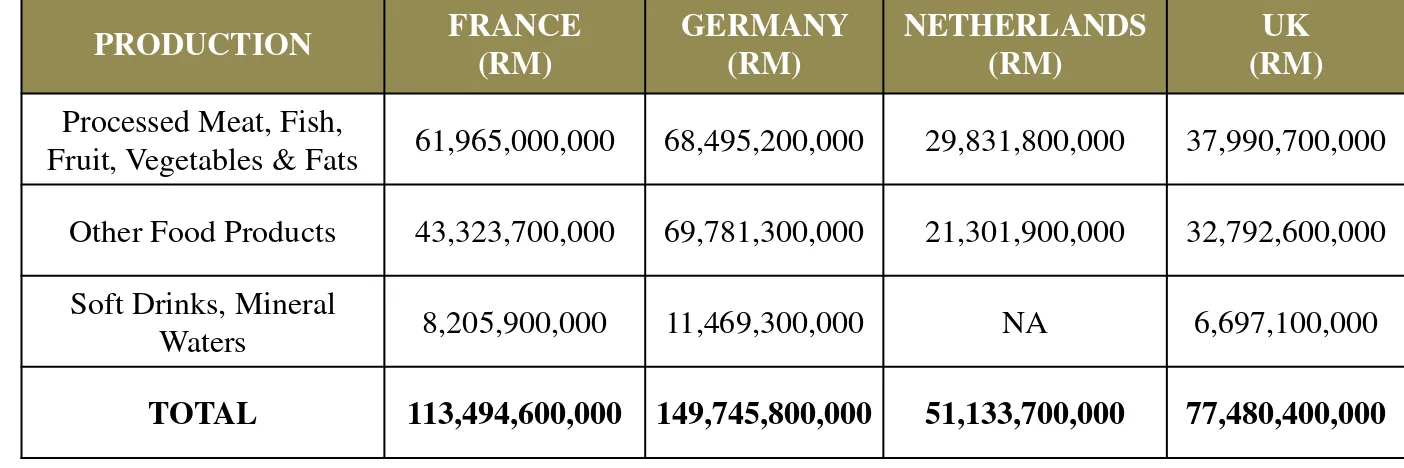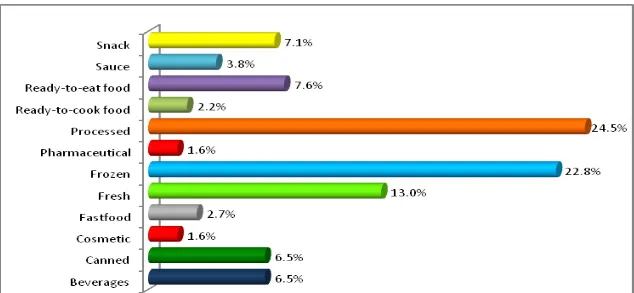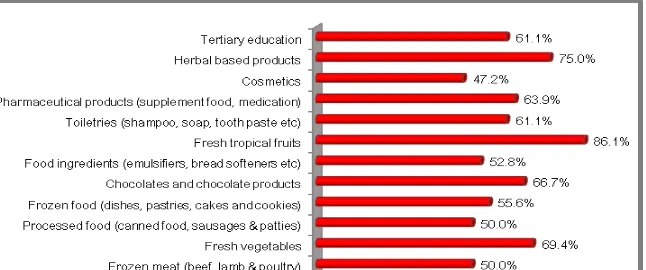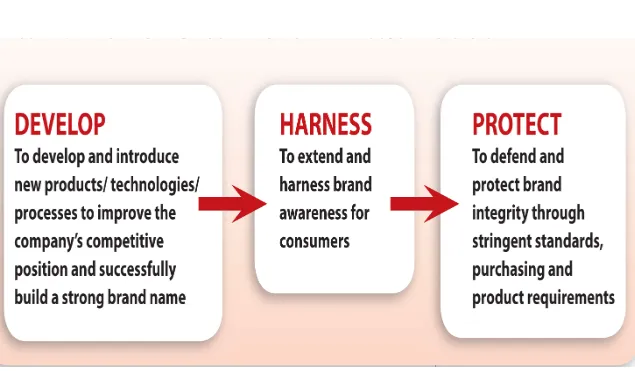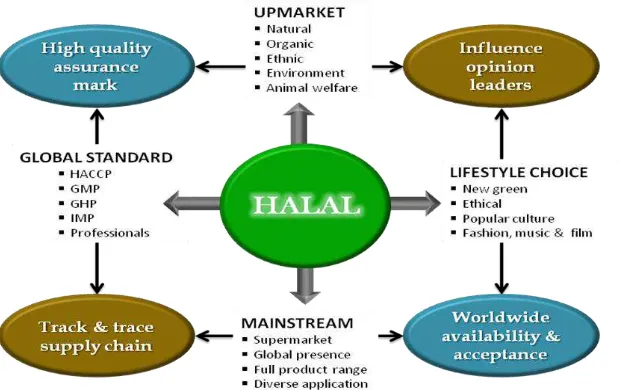KAJIAN POTENSI PRODUK MAKANAN
HALAL MALAYSIA DI PASARAN
DOMESTIK DAN GLOBAL
Domestic and International Market Potential
of Malaysia’s Halal Food Products
MAHA 2012 (25 Nov 2012)
PRESENTED BY:
Associate Professor Dr. Rosidah Musa
Institute of Business Excellence, Faculty of Business Management,
OBJECTIVES OF THE STUDY
•
Identify the potential market for Halal products in the
domestic and international market.
•
Identify the Potential Halal Products For Domestic and
International Market.
•
Develop a Database of Potential Market for Halal Food for
the Domestic and International.
•
Recommend Marketing Planning for Halal Food Products.
SCOPE OF THE STUDY
•
Secondary data on Halal food through the acquisition and
purchase the report from the relevant agencies or departments of
statistics in the country and abroad.
•
In terms of products, this study documented the potential market
for Halal food-based products (food processing, beverages,
sweets, snacks) and health food product.
•
Consumer attitudes, preferences and market acceptance of Halal
food produced by Malaysian entrepreneurs in the international
market. This includes studies of new and innovative products to
penetrate global markets.
METHODOLOGY
The study was conducted in three phases:
• Collection and analysis of secondary data was derived from economic reports, statistics and relevant data within and outside the country. It includes secondary data available from the Federal Agricultural Marketing Authority (FAMA) derived from research reports and promotions in overseas exhibitions in previous years.
• This study detailed the market of consumer tastes and trends in the demand for Halal food products produced by Malaysian entrepreneurs and manufacturers to a number of countries that have been identified to have potential market (United Kingdom, the Netherlands, Germany, UAE (Shahjar, Dubai, Abu Dhabi), Saudi (Jeddah, Makkah, Madinah, Riyadh), and Qatar. In addition, these countries have high-yield currencies and the purchasing power of the buyer.
FINDINGS AND ANALYSIS
OBJECTIVE 1:
• IDENTIFY THE POTENTIAL MARKET FOR HALAL PRODUCTS IN THE DOMESTIC AND INTERNATIONAL MARKETS
• Estimated Halal market values of the states in Malaysia.
Malaysia has with a total Muslim population of 17.4 million and the estimated domestic Halal market value is worth more than RM52 billion.
Therefore, the present market potential in Malaysia is about RM16 billion (RM52 billion – RM 36 billion).
• The top three states of highest market value (above RM4 billion) are Selangor,
Sabah, Johor, Kedah and Kelantan with cumulative amounts of RM31 billion
STATE TOTAL
Johor 3,348,283 58.22 1,949,393 3,013.40 5,874,300,866
Kedah 1,947,651 77.23 1,504,100 3,013.40 4,532,454,940
Kelantan 1,539,601 95.18 1,465,388 3,013.40 4,415,800,199
Melaka 821,110 66.06 542,433 3,013.40 1,634,567,602 Negeri Sembilan 1,021,064 60.25 615,235 3,013.40 1,853,949,149 Pahang 1,500,817 74.95 1,124,909 3,013.40 3,389,800,781 Perak 2,352,743 55.34 1,301,931 3,013.40 3,923,238,875 Perlis 231,541 87.88 203,476 3,013.40 613,154,578 Pulau Pinang 1,561,383 44.63 696,846 3,013.40 2,099,875,736
Sabah 3,206,742 65.37 2,096,153 3,013.40 6,316,547,450
Sarawak 2,471,140 32.22 796,239 3,013.40 2,399,386,603 Selangor 5,462,141 57.89 3,161,994 3,013.40 9,528,352,720
Terengganu 1,035,977 96.93 1,004,152 3,013.40 3,025,911,637
W.P. Kuala Lumpur 1,674,621 46.4 776,958 3,013.40 2,341,285,237
W.P Labuan 86,908 76.02 66,065 3,013.40 199,080,271 W.P Putrajaya 72,413 97.39 70,522 3,013.40 212,510,995
TOTAL 28,334,135 61.32% 17,375,794 52,360,217,640
* Per capita Food and Non-Alcoholic Beverages
Table 1: Estimated Malaysia’s Halal Market Value by States
Sources:
•Population Distribution and Basic Demographic Characteristics2010, Department of Statistics Malaysia
PRODUCTION
MALAYSIA (RM)Processed Meat, Fish, Fruit, Vegetables & Fats 121,823,400,000
Other Food Products 21,895,500,000
Soft Drinks, Mineral Waters 3,859,200,000
TOTAL 147,578,100,000
The Total Malaysia’s food production is worth RM147 billion. The total Halal food market is worth about RM36 billion (Mohd Raimee, HDC 2012). Thus, the country’s certified Halal food market is 25% (RM 36 billion / RM 147 billion) only.
Table 2:
Malaysia’s Food Production in 2011
MARKET POTENTIAL OF
INTERNATIONAL MARKET
The total consumer expenditure on food and
non-alcoholic beverages by the Muslim population in
selected European Union countries worth almost
COUNTRY TOTAL
France 63,300,000 6,080,000 3,250.80 59,294,592,000
Germany 81,800,000 4,090,000 2,627.50 32,239,425,000
Netherlands 16,700,000 920,000 2,558.30 7,060,908,000
United Kingdom 62,700,000 2,880,000 2,280.40 19,702,656,000
TOTAL 224,500,000 13,970,000 118,297,581,000
Source:
•www.muslimpopulation.com
•Euromonitor International from National Statistics/UN/OECD, 2012
Table 3: Consumer Expenditure on Food and Non-Alcoholic Beverages 2011
PRODUCTION FRANCE
Fruit, Vegetables & Fats 61,965,000,000 68,495,200,000 29,831,800,000 37,990,700,000
Other Food Products 43,323,700,000 69,781,300,000 21,301,900,000 32,792,600,000
Soft Drinks, Mineral
Waters 8,205,900,000 11,469,300,000 NA 6,697,100,000
TOTAL 113,494,600,000 149,745,800,000 51,133,700,000 77,480,400,000
Table 4: Production of Food and Non-Alcoholic Beverages for 2011
The total production of food and non-alcoholic beverage is worth
about RM78 billion. Thus, there is still about RM42 billion worth of
Halal food and beverage potential in this region.
Table 5 shows that the Muslim consumer food and non-alcoholic beverages expenditure in selected GCC countries is worth RM242 billion. The main markets are Saudi Arabia and United Arab Emirate, contributing more than RM71 billion.
COUNTRY TOTAL
Bahrain 1,300,000 1,300,000 846.6 1,100,580,000.00 Kuwait 2,800,000 2,800,000 1,778.60 4,980,080,000.00 Qatar 1,700,000 1,700,000 1,687.70 2,869,090,000.00 Saudi Arabia 29,200,000 29,200,000 1,628.50 47,552,200,000.00
UAE 7,900,000 7,821,000 3,106.90 24,299,064,900.00
TOTAL 42,900,000 42,821,000 242,403,044,700.00
Table 5: Consumer Expenditure on Food and Non-Alcoholic Beverages 2011
PRODUCTION GCC (RM)
Processed Meat, Fish, Fruit, Vegetables, Fats 21,300,000 Other Food Products 67,400,000
TOTAL 88,700,000
Table 6 depite the total production for food and non-alcoholic beverage is only RM88.7 billion.
This shows a market potential worth about RM153 billion for Malaysia to capture (RM 242 bil – RM89 bil).
Table 6: Production of Food and Non-Alcoholic Beverages for 2011
OBJECTIVE 2: IDENTIFY THE TYPES OF POTENTIAL HALAL PRODUCTS FOR DOMESTIC AND INTERNATIONAL MARKETS
Type of Potential Products:
Majority of the respondent preferred the processed (24.5%) and frozen (22.8%) food product. They also love the other Halal food products such as 'ready-to-eat’ food (7.6%) and snack (7.1%).
Figure 2: Preference of Malaysia’s Halal Products
EUROPEAN MARKET – INTERNATIONAL MARKET
Type of Potential Products
UNITED ARAB EMIRATES (UAE) AND KINGDOM OF
SAUDI ARABIA (KSA)
–
INTERNATIONAL MARKET
a.Type of Potential Products
25% wants processed food and another 23% are looking for frozen food. 13% who wants fresh produce, whilst ready-to-eat food and snacks scored 8% and 7% respectively.
Both canned food and beverages are looked for by 7%.
OBJECTIVE
3:
DEVELOPING
A
DATABASE
OF
POTENTIAL MARKET FOR HALAL FOOD FOR THE
DOMESTIC AND INTERNATIONAL
FOOD CATEGORY FOOD TYPES EXAMPLES
Fresh Produce Meat, vegetables and fruits Variety
Processed Food (Beef, Chicken, Seafood)
Sausages, Cocktails, Franfurters,
Nuggets, Balls and Pate Ayamas, Baguz
Frozen Food Meat, poultry & local cakes Spring roles, paratha, curry puffs, vade and etceteras
Ready-to-eat Local, asian and western dishes Curry, kurma, gulai lemak, sambal, rendang and etceteras
Ready-to-cook Instant noodles, rice and dishes Asam pedas, nasi beriani, kuah kacang etceteras
Confectioneries Cocoa based, sweets & cereal Chocolates, cookies, sweets and cereal biscuits and breakfast.
Products for EU
–
International Markets
Table 8: Products for EU Market
FOOD CATEGORY FOOD TYPES EXAMPLES
Frozen Food Meat, poultry & local cakes Spring roles, paratha, curry puffs, vade and etceteras
Ready-to-eat Local, asian and western dishes
Curry, kurma, rendang, sambals, gulai lemak, asam
pedas etceteras
Ready-to-cook Instant noodles, rice and dishes
Beriani and pilau rice, pastes, herbs and
ingredients
Beverages Fresh, cordial juices and health drinks
Golden Hope products and Power Root
FOOD CATEGORY FOOD TYPES EXAMPLES
Processed Food (Beef, Chicken, Seafood)
Sausages, Cocktails, Franfurters,
Nuggets, Balls and Pate Ayamas, Baguz
Frozen Food Meat, poultry & local cakes Spring roles, paratha, curry puffs, vade and etceteras
Ready-to-eat Local, asian and western dishes Curry, kurma, rendang, stews etceteras
Ready-to-cook Instant noodles, rice and dishes Beriani and pilau rice, pastes, herbs and ingredients
Confectioneries Cocoa based, sweets & cereal Chocolates, cookies, sweets and cereal biscuits and breakfast.
Beverages Fresh, cordial juices and health and power drinks
Golden Hope products and Power Root
Processed Food (Beef, Chicken, Seafood)
Sausages, Cocktails, Franfurters,
Nuggets, Balls and Pate Ayamas, Baguz
Products for UAE and KSA
–
International Markets
SWOT Analysis:
Before strategic marketing strategies could be formulated,
the SWOT analysis needs to be concluded.
From the various primary and secondary data collections,
Malaysia’s
strengths and weaknesses are summarized
below
;OBJECTIVE 4:
RECOMMENDED MARKETING STRATEGIES
FOR
HALAL
PRODUCTS
WHICH
IS
STRENGTHS
Global recognition of JAKIM Halal certification and auditing activities which is at par with global Halal requirements (Bernama, 2011).
High level of consumers’ confidence and trust towards Malaysia’s Halal logo/labels (Bidin, 2009).
Lucrative incentives for Halal food products investors.
Global consumers have positive perception about Malaysia in general.
WEAKNESSES
Malaysia does not have sufficient supply of meat and poultry to export (Temporal, 2009).
SMEs’ limited production capacity could not fulfill large volume purchase
Shorter product shelf-life (products have to be taken off on the shelf 6 months before expiry date). This means the products selling time is within 3 months only).
Insufficient marketing efforts.
THREATS
Physical present of non-Halal elements in Halal-labeled products in the form of emulsifier, gelatin, enzymes, glycerin and lecithin.
The pre-stunning slaughtering is not considered Halal by certain groups of Muslim consumers (Halal Scholar UK, 2009).
Rising concerns over health and nutritional values (Need to educate consumers that Halal + toyibban = healthy, natural and wholesome).
Negative mindset about Halal industry.
Negative perception about Muslims – islamophobia.
OPPORTUNITIES
Willingness to pay premium price for Halal food products (Bernama, 2011).
Rising consumers’ religiousness, techno-savvy and knowledgeable younger generation are demanding fast and convenient Halal food choice (Sungkar, 2010).
Muslim consumers are seeking for total Halal lifestyle (Razak, 2010). (Not just Halal food but also Halal finance, housing, cosmetics, pharmaceutical, tourism, entertainment and etc.).
Proposed
Malaysia’s
Halal Food Products Value
Chain Strategies
Organizations have to control its internal environment, to managed and create
increased values to customers and business ((Porter, 1980).
Both primary (inbound and outbound logistics, operations, marketing, sales and services) and secondary (company infrastructure, human resource management, technology and procurement) activities of the value chain can be managed to reduce costs, create or enhance differentiation or combination of both.
Primary activities
•Sourcing from reliable suppliers for raw materials and packaging •Tailor-made products according to market
•Strategic alliance with downstream activities
•Promote warehousing and inventory control methods •Look for highest quality products
•Provide variety of methods for customer to access the Halal food products
•Use a variety of ways for customers to access information about products and make purchases.
•Continuous promotional research to ensure effectiveness.
Secondary activities
•Provide telemarketers to assist customers instead of computerized answering system.
•Database customer records must be very specific and details and ensure easy access.
•Use technology for better and faster customer service •Review supply source and ensure materials availability
Proposed 4P’s Marketing Strategies
for Malaysia Halal Food Products
•
Product Strategies
Branding
•
Malaysia is well-known globally as an Islamic
Figure 4: Effective Branding Strategy for Halal Food Industry
Packaging & labeling
New Product Development
• Introduce more ready to eat (RTE) or ready to cook (RTC) food products for the modern household, whereby both husband and wife are working.
Price
•
Premium price vs. Penetration price
• Today consumers are young, techno savvy, more knowledgeable and highly educated are seeking more convenience, easy to prepare fusion food. They are willing to pay premium price for wholesome, organic, natural and healthy food products.
Distribution Channel
• Each market differs from one another. The GCC gateway is Dubai and the corporate buyers in Dubai are mostly from India, Pakistan and Bangladesh. Thus, the need to break into this close-knitted distribution channel is crucial to penetrate this market.
Promotion
• The Halal Malaysia campaign should be extended to the global market since the term itself self-promote Malaysia and its Halal food products.
• Besides educating and strengthening the consumers’ awareness on Malaysia and its Halal products, the logo is positioning itself in the mind of the consumers. Hopefully, the term Halal would be associated with Malaysia.
Issues for Considerations
•
Sustainability of Supply
• Malaysia Halal food products have been everywhere (London. Emirates, Saudi). Unfortunately, most of the time, it was a one off situation, whereby there is no continuous and long term supply.
• This is due a number of reasons such as Malaysia’s SMEs producers are not able to fulfill large volume of orders. This could be because the SMEs are small, cottage industry without large scale production capacity.
• The lack of acreage for fresh fruits, herbs and vegetables also is limiting the quantity to be exported out of the country.
Collaboration vs. Competition
POTENTIAL RESEARCH AREAS
• The monitoring and maintaining the high level of quality, distinguish the need to set global standard and measurement. The current standard may be sufficient at this point of time but as the industry expanded, more standards and measures have to be developed.
CONCLUSION
• This study found that the potential market for Halal food products in the domestics is about RM16 million. There is about RM42 billion and
RM154 billion for EU and UAE & KSA markets respectively. Thus, this pointed out that Malaysia has vast opportunities to dominate the halal food product's market in domestic and international.
